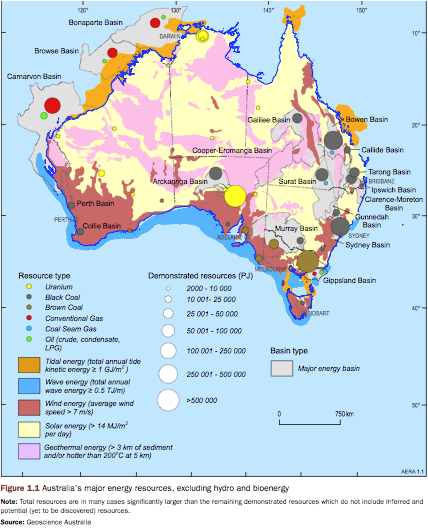The Australian Energy Resource Assessment
Posted by Big Gav on March 3, 2010 - 6:14am in The Oil Drum: Australia/New Zealand
Geoscience Australia and ABARE have released a report into Australia's energy resources, entitled the "Australian Energy Resource Assessment".
The report analyses both traditional (legacy) sources of energy and renewable energy, concluding oil supplies are declining and imports growing, while there is massive unexploited potential in renewable energy sources.
Australia’s oil resources are in decline with remaining crude oil resources estimated to be 8414 PJ (1431 million barrels, mmbbl) and located mostly in the Carnarvon and Gippsland basins. Without significant new discoveries of crude oil, or development of condensate and LPG resources associated with offshore gas resources, or other alternatives, Australia is likely to be increasingly dependent on imports for transport fuels. ...
Australia’s potential renewable resource base is also very large, and includes wind, solar, bioenergy, geothermal, wave and tide as well as hydro resources. Hydro and increasingly wind energy are used in electricity generation. Biomass and solar energy are both being used for heating and electricity generation.

The SMH's article on the report focused on the depletion of oil reserves - Australia's oil reserves 'dwindling' (though its worth noting production is on the rise at the moment, as BusinessWeek points out - Australian Oil, LNG Production to Increase Next Year).
Gas Today is focusing on the gas aspect, noting that gas is expected to "be the source of more than one third of Australia’s electricity generation by 2030" - Gas-fired generation in Australia set to increase: Ferguson.




So, buy gas shares eh?
;-)
"Marn" Ferguson is quoted in today's SMH as saying...
Has anyone considered that there may not be any imports to be had? Last time I checked, our top source-countries for oil were (amazingly, in order of importance) Vietnam, China and Angola... (Yikes! "Export-Land Model" anyone?)
In Chapter Three, on oil, it says that a key assumption is that oil is available for import to meet future demand (we will only be importing 75% of oil requirement by 2030....)
In my line of work, you do as much as you can to the confirm validity of an assumption, but apparently Govt is excused from that responsibility. There does not appear to be any analysis whether this assumption is valid. Maybe they know that if they do ask the question, the answer will be ugly.
Some interesting reading in this report.I recommend downloading the solar,geothermal and uranium/thorium sections as they have particular relevance to getting fossil fuels out of Australian baseload electricity generation.
buying fuel is an option,however the bigger picture to reduce the
carbon footprints would be to focus on alternate fuels and hybrids,
See. Yous is all rong.
Says so here in the Assesment.
A very interesting report. I also noticed that the minister Martin Ferguson? was on A-PAC last night talking about it. His knowledge of the subject seemed quite impressive for a politician.
Another thing I notice is that for all the talk/hype about the Queensland coal seam gas resources they seem puny compared with both the conventional gas resources off the coast of WA and the black and brown coal reserves in the Eastern states.
Compared with other countries Australia is truly the Lucky Country when it comes to Energy resources. Now all it needs to become is the Smart Country to actually exploit them.
Ummmm - the assessments I've seen in recent years of CSG resources (as opposed to reserves) show them being roughly equivalent to offshore natural gas.
http://anz.theoildrum.com/node/4094
http://peakenergy.blogspot.com/2008/10/coal-seam-gas-producers-new-maste...
http://anz.theoildrum.com/node/6203
Mr Ferguson isn't held in high esteem amongst most commenters here (he's made a few howlers over the years) or elsewhere (the solar industry and the greens, for starters).
http://www.smh.com.au/business/futures-not-looking-sunny-20100305-poze.html
I thought the same about CSG but judging by the size of the little blue dots on the diagram (above) the demonstrated reserves seem much less than offshore.
I went away feeling that the Minister knew his stuff. The questions from the journalist were a bit of a let down more than the Minister, they were all predictable, one on nuclear and dumping, one on foreign ownership i,e, China. He did however stumble at one point appearing to confuse Wave and tidal energy.
Anyway I will look at those links for a better idea of CSG rather than relying upon the size of blue dots.
Marn isn't completely ignorant (unlike most journalists) he just has a reflexive bias towards the fossil fuel industry and against renewables.
The CSG dots are fine but they are proven reserves, not the likely resource (see the links) - the reserve numbers keep growing as companies drill holes and "prove" the gas exists, and this will keep going until the blue dots are roughly the size of the offshore NG reserves...